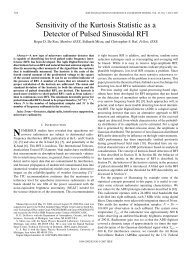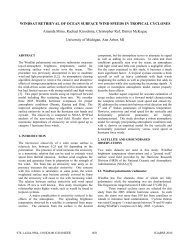Jason Microwave Radiometer performance and on-orbit - Remote ...
Jason Microwave Radiometer performance and on-orbit - Remote ...
Jason Microwave Radiometer performance and on-orbit - Remote ...
You also want an ePaper? Increase the reach of your titles
YUMPU automatically turns print PDFs into web optimized ePapers that Google loves.
<str<strong>on</strong>g>Jas<strong>on</strong></str<strong>on</strong>g> <str<strong>on</strong>g>Radiometer</str<strong>on</strong>g> Performance <str<strong>on</strong>g>and</str<strong>on</strong>g> Calibrati<strong>on</strong> 209TABLE 4 Statistics of the V-pol–H-pol TB Difference from SSM/I Data for Jan.–Sep.2002 Over two Heavily Vegetated Regi<strong>on</strong>s of the Amaz<strong>on</strong> Rainforest (Regi<strong>on</strong> 1 is5 ◦ –10 ◦ S <str<strong>on</strong>g>and</str<strong>on</strong>g> 65 ◦ –74 ◦ W <str<strong>on</strong>g>and</str<strong>on</strong>g> Regi<strong>on</strong> 2 is 1 ◦ S–4 ◦ N <str<strong>on</strong>g>and</str<strong>on</strong>g> 53 ◦ –59 ◦ WAbs(V-pol minus H-pol) TB Regi<strong>on</strong> 1 Regi<strong>on</strong> 219.35 GHz Mean: 0.9198 K Mean: 0.7636 KSt. dev.: 0.6717 K St. dev.: 0.5767 K37.0 GHz Mean: 1.0115 K Mean: 0.8011 KSt. dev.: 0.7258 K St. dev.: 0.5785 Kregi<strong>on</strong>s at 19.35 <str<strong>on</strong>g>and</str<strong>on</strong>g> 37.0 GHz. The small (∼1 K) V-pol minus H-pol TB differences indicatethat the chosen Amaz<strong>on</strong> reference regi<strong>on</strong>s are emitting essentially as black bodies.The SSM/I observati<strong>on</strong>s from F13, F14, <str<strong>on</strong>g>and</str<strong>on</strong>g> F15 platforms were c<strong>on</strong>verted to JMRreference TBs using the methods described in the appendix. Table 5 shows the referenceTBs from all three platforms <str<strong>on</strong>g>and</str<strong>on</strong>g> the average values across the platforms. The averagesin Table 5 represent SSM/I overpass data from 4 February 2001 through 15 August 2001,which corresp<strong>on</strong>ds to the start of JMR cycle 3 through the end of JMR cycle 21. Eachplatform has morning <str<strong>on</strong>g>and</str<strong>on</strong>g> evening local overpass times. The average of all the platformsc<strong>on</strong>sists of six local times (6, 8, 10, 18, 20, 22 LST). A large JMR time series, the cycle 3–21average, was used for comparis<strong>on</strong> to get an adequate sampling of data <str<strong>on</strong>g>and</str<strong>on</strong>g> local overpasstimes. The average calibrated JMR TBs over the same regi<strong>on</strong>s <str<strong>on</strong>g>and</str<strong>on</strong>g> same time period arepresented in Table 6. The JMR TBs are within ∼0.5 K for the 23.8 <str<strong>on</strong>g>and</str<strong>on</strong>g> 34.0 GHz channels.The 18.7 GHz hot TBs are 1.6 K lower than the reference, but this has little affect <strong>on</strong> theretrieved path delays since most of the open ocean TBs are near the cold calibrati<strong>on</strong> point.JMR Wet Path Delay Validati<strong>on</strong>Results of Comparis<strong>on</strong> with TMR PDsThe availability of TMR in an identical <strong>orbit</strong>, with <strong>on</strong>ly 70 sec<strong>on</strong>ds of separati<strong>on</strong> from JMR,allows for unprecedented accuracy in the intercalibrati<strong>on</strong> of the JMR <str<strong>on</strong>g>and</str<strong>on</strong>g> TMR path delaymeasurements. TMR has been extensively calibrated against various sources of ground truth<str<strong>on</strong>g>and</str<strong>on</strong>g> has been dem<strong>on</strong>strated to have PD accuracy of 1.1 cm (Keihm et al. 2000). The initialcomparis<strong>on</strong> with TMR showed that JMR was biased 8–12 mm, JMR low. There was alsoa large PD scale error. The path delay bias was approximately 15 mm, JMR low, for dryTABLE 5 JMR Hot TB Calibrati<strong>on</strong> References Derived from SSM/IPlatforms F13, F14, <str<strong>on</strong>g>and</str<strong>on</strong>g> F15 Over Regi<strong>on</strong> 1 <str<strong>on</strong>g>and</str<strong>on</strong>g> 2 (F13 is at Local Time6 <str<strong>on</strong>g>and</str<strong>on</strong>g> 18, F14 is at 8 <str<strong>on</strong>g>and</str<strong>on</strong>g> 20, <str<strong>on</strong>g>and</str<strong>on</strong>g> F15 is at 10 <str<strong>on</strong>g>and</str<strong>on</strong>g> 22. Data is fromFebruary Through August of 2002, JMR Cycles 3–21.)Nadir hot reference TB (Regi<strong>on</strong> 1/Regi<strong>on</strong> 2) (K)Local time 18.7 GHz 23.8 GHz 34.0 GHz6, 18 285.0/285.6 284.3/284.4 281.0/281.48, 20 286.6/287.1 285.5/285.6 282.8/283.310, 22 287.7/287.8 286.7/286.3 283.4/283.4Average over time 286.6 285.5 282.6<str<strong>on</strong>g>and</str<strong>on</strong>g> regi<strong>on</strong>





